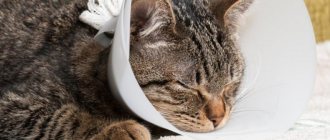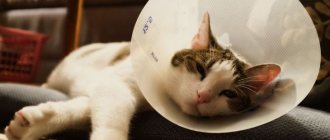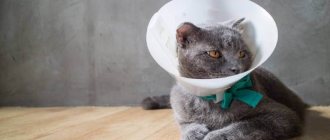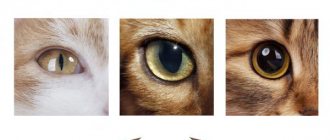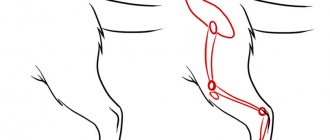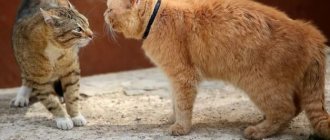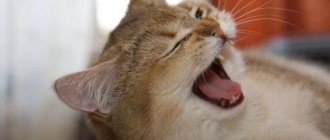The natural reflex of cats to lick their wounds in some situations harms them. Although this unique method of disinfection helps animals survive in the wild, it is not suitable for pets. There are more effective methods for disinfecting and healing wounds. But measures must be taken to prevent scratching and biting, which interfere with recovery. If you can protect a dog with a muzzle, then a veterinary collar will help a cat.
What is a protective collar for a cat?
A cat collar is usually referred to as a cone-shaped design. Other names are simpler - cone or cap. The design is made of durable material, narrowed on one side and larger in diameter on the other. This accessory is a popular tool in animal therapy using barrier structures.
A cat in protection will not be able to scratch unhealed wounds
The cap is used to protect and restrict access of a kitten or adult cat to areas of the body in the following cases:
- rehabilitation after castration;
- surgical interventions;
- processing wool with chemicals;
- recovery after abdominal surgery.
In all of these situations, the animal should not have even the slightest chance of scratching or gnawing wounds, or licking fur treated with chemicals. The main purpose of the barrier is to protect the animal and prevent it from harming itself.
When to use
Initially, the veterinary collar was a post-operative accessory, but the scope of the protective collar for cats has expanded over time. This means of barrier therapy is used both in a hospital hospital setting and at home.
When to use a collar
- After castration and sterilization operations, so that the animal does not lick the stitches, irritating the wound.
- After treating open wounds with ointments and powders to prevent the animal from licking them.
- During the course of treatment for ear mites, prevent your pet from scratching its ears.
- After treating the animal’s coat with antiparasitic agents: sprays, drops, shampoos. The cat will not be able to lick off the harmful medicine.
- If your pet is sick with lichen or another fungal disease and needs to treat the affected areas with antifungal ointments.
- After a fight or injury, if the cat needs treatment for scratches and wounds.
- In the postoperative period - after any abdominal surgery, injuries of the limbs and spine, traumatic brain injuries.
- During the treatment of allergic and infectious skin diseases.
- After eye surgery and time of treatment of ophthalmological diseases.
Why do you need a veterinary collar for cats?
This barrier protection product performs the following functions:
- Prevents the cat from removing post-operative dressings.
- Protects seams and open wounds from infection and injury.
- Allows medications (ointments, drops, powders) to be absorbed.
- Protects fastenings of metal structures in case of limb fractures.
- Prevents the licking of toxic medications (anti-parasitic drops).
- Protects the cat's head from scratches and scratches.
- Does not allow the bandage to be torn off from the head and eyes.
How long should you wear the collar?
The cat cone is used as prescribed by a veterinarian and is not removed from the animal until the wound has completely healed. Depending on the severity of the wound, the wearing period can range from several days to several weeks. During this period of time, the animal should not be allowed outside.
Wearing a special collar increases the effectiveness of many therapeutic measures and promotes a speedy recovery of the cat in the postoperative period.
In what cases is protection not needed?
Do-it-yourself collar for a dog after surgery
Freedom-loving animals have difficulty accepting a new wardrobe item. Therefore, if the pet cannot calm down, the veterinary cap will have to be removed.
There are times when completely getting rid of an accessory that is unpleasant for an animal is simply dangerous for its health. In such cases, it is necessary to replace the barrier structure with a bandage that is tied on the back. Animals perceive such a unique T-shirt more calmly.
A cat wearing a bandage feels more confident
Replacement option
If your pet does not want to put up with a device on his neck, you will have to buy or sew him a dress that will cover the wound.
Just keep in mind that this option is not suitable in all cases.
When treating wool and skin with various medications, you cannot do without a collar.
What to look for when choosing
A veterinary accessory significantly complicates the life of an animal, so its choice should be taken with full responsibility. Choosing a veterinary collar for a cat is quite difficult, since you need to take into account many nuances.
House for a cat: options for how to make it yourself
The part of the product adjacent to the neck should be soft, ideally covered with fabric. The height of the cone should not be too high so as not to interfere with the view. However, a low one will not work, otherwise it will lose its functionality.
Additional Information! Size is the most important criterion. The kitten should not remove the product easily. But it is worth considering that a narrow collar will put pressure on the neck. A product that holds its shape well is considered good.
Tools and materials
Nothing fancy is required. It is enough to have a plastic cloth, a sharp knife, a felt-tip pen and tape on hand.
In order not to make a mistake with the dimensions, you should make a pattern, and for this prepare:
- A sheet of paper (a double piece of paper from a school notebook);
- Ruler;
- Pencil;
- Compass;
- Centimeter.
Size chart of protective collars for cats - table
The big advantage of this category of veterinary product is that it can be selected in size according to the parameters of the animal. The following table will help you buy the right barrier cap:
How to make a house for a cat with your own hands: patterns
| Neck circumference (cm) | Collar height (cm) | Marking number |
| 22-25 | 7 | 7 |
| 22-25 | 10 | 10 |
| 28-33 | 12 | 12 |
| 31-38 | 15 | 15 |
| 38-44 | 20 | 20 |
| 44-50 | 25 | 25 |
| 47-57 | 30 | 30 |
This information is very helpful when purchasing a barrier for your furry friend.
The main thing is to take measurements of your pet correctly. For your information! A cat collar can be made from cardboard, plastic, fabric and other materials. Each of them has its own pros and cons.
Progress
You need to start making a veterinary collar for a furry pet by creating a pattern. To do this, you will need to take two measurements - neck circumference and the distance from the tip of the nose to the cat's neck.
Next steps:
- Two circles are drawn on a piece of paper: one is the size of the neck circumference, the second is the distance from the nose to the neck (two to three centimeters should be added). The center for both circles must be common.
- Inside the smaller circle (we step back a couple of centimeters from the edges) another circle is drawn where the clasps for the collar will be located.
- The pattern is cut along a large circle (you can make an allowance of a few centimeters).
- The next step is to cut the workpiece straight from the edge to the center.
- The smallest circle is cut out.
- We try the pattern on the cat and make adjustments if necessary.
- We place the pattern on plastic and use a felt-tip pen to outline the contours.
- We fix the places for the loops.
- We thread a bandage (rope) through the loops and secure the entire structure to the animal.
The result is a collar that is practically no different from the factory sample.
How to make a fabric collar
When it is not possible to buy a barrier structure, it can be made from a comfortable collar and scrap materials that you have at home. There is nothing complicated about this. It is enough to follow the step-by-step instructions, and then everyone will be able to cope with this task.
Made from soft fabric
It is important to take care of the animal's comfort. A veterinary cap made of fabric is considered the most convenient. When wearing it on the neck there is practically no load. It does not bother the cat, adapting well to its body.
Such a cone is sewn from natural fabrics such as linen or cotton. The pattern is outlined on the fabric and the blank is cut out, and then all the parts are sewn together.
Important! Fabric products do not hold their shape well. To make them stronger and more stable, plastic or plastic stands are used. Or you can simply fold the fabric in several layers.
The fabric collar does not put pressure on the pet's neck
Made from thick fabric
The product is made according to the same principle as in the previous version. Just choose a denser fabric - non-woven fabric, felt. Dense material holds its shape better, so one layer will be enough to make a high-quality barrier.
Feature of the pattern
When making a protective cap for a cat yourself, you will have to prepare a pattern. It looks like a half ring.
The collar should not interfere with the pet’s view, so before starting work it is necessary to measure the circumference of the neck, which will correspond to the length of the inner line of the semi-ring. The length of the pattern should be with a margin of 2 cm.
The collar pattern is very simple
Ready-made models
A medical collar for cats can be purchased at a pet store, veterinary pharmacy, or through an online pet supply store. The modern pet industry offers a wide variety of models. We analyzed market offers, reviewed the characteristics and compiled the TOP models.
Plastic
The bulk of the products are made of transparent and translucent plastic. These are lightweight, comfortable accessories that do not interfere with the cat’s view and are easy to care for.
Popular models:
- Protective collar for cats with collar (TOSHKA and KO);
- Talismed Collar;
- Avita group.
Protective collar with collar (TOSHKA and KO)
The design is made of transparent durable plastic and is secured with Velcro. The comfortable collar makes it easy to put on the collar. Available in different neck diameters, allowing you to choose the size you need. Flexible plastic is fracture resistant. The animal does not lose orientation when moving due to the transparency of the product.
- Plus: the sharp edge of the product is finished with a fabric edging.
- Minus: you need to select the size.
Prices depend on size: from 190 to 995 rubles.
https://mastergroom.ru/hand-tools/fiksacija/vorotnik-zaschitnyj-dlja-koshek-i-sobak–toshka-i-ko
Collar Talismed
The protective cone for cats is made of high-quality plastic and is attached to the collar using three fasteners. A latch-tongue is used for fixation and adjustment. Available in several sizes.
- Pro: Suitable for dogs.
- Cons: sharp edges.
Price: from 101 to 324 rubles.
https://www.petshop.ru/catalog/dogs/vet/vorotniki_popony/vorotnik_plastikovyy_zaschitnyy_7_5_21_26sm_19135/
Avita-group
The convenient plastic design is equipped with soft loops made of non-woven material for attaching to a cat's collar. It has several diameters, which allows you to choose the size you need. Fixed with Velcro. The transparent plastic of the collar does not interfere with good visibility.
- Plus: no sharp edges.
- Cons: Requires sizing.
Price: from 95 to 150 rubles.
https://www.petshop.ru/catalog/dogs/vet/vorotniki_popony/vorotnik_zaschitnyy_plastikovyy_7_5_sm_18762/
Soft
Unlike hard plastic structures, soft models are made of opaque fabric and non-woven materials. Collars are produced in the shape of a truncated cone, equipped with Velcro fasteners and attachments to the collar. It is more comfortable to sleep in soft models, but in them animals are less oriented in space.
Popular models:
- Freddy's Friends Brand Pillow Collar;
- Medical collar OSSO;
- Kruuse Buster Soft Collar;
- Disposable post-operative collar Kruuse Buster.
Freddy's Friends Brand Pillow Collar
A very comfortable and soft alternative to plastic structures. The product is made in the form of a round pillow made of durable water-repellent Oxford fabric. Additional softness is provided by synthetic padding. Fixed around the neck with a cord with a clip.
- Plus: good review.
- Cons: high price.
Price: from 850 to 1150 rubles.
https://www.freddysfriendsbrand.com/
Medical collar OSSO
The model is made of durable Oxford fabric - a cat will not be able to tear it. To secure it on the animal's neck, the collar is equipped with a Velcro collar. The cat experiences less discomfort when wearing it, thanks to the small dimensions of the product and its flexibility.
- Plus: does not affect the animal’s thermoregulation.
- Cons: bad review.
Price: from 190 to 455 rubles.
https://mastergroom.ru/hand-tools/fiksacija/veterinarnyj-vorotnik-osso
Kruuse Buster Soft Collar
This simple fabric model is made in the shape of a four-section cone. The fabric is water-repellent. The edges of the product are finished with piping. Fixation is carried out using lace and loops.
- Plus: has good flexibility.
- Cons: bad review.
Price: from 120 to 200 rubles.
https://lemurrr.ru/product/00011005240
Disposable post-operative collar Kruuse Buster
The collar is intended for one-time use after surgery. Made from non-woven waterproof material. The non-rigid design makes it easier for the pet to see and does not interfere with daily functions. Fixed around the neck with a drawstring.
- Plus: it doesn't rub your neck.
- Cons: disposable.
Price: from 150 to 170 rubles.
https://www.ozon.ru/context/detail/id/33519039/
DIY Elizabethan cat collar made from cardboard
This design provides assistance during the rehabilitation of pets after operations. The main thing to consider is that the collar should be comfortable.
If it is not possible to buy a suitable accessory, then the most affordable option would be a homemade cardboard collar. You can use any cardboard box from which 2 semicircles are cut out, the inner diameter of which should be the length of the collar. Then use tape to connect both parts.
The collar is attached to the collar. In order not to spoil it, you need to put a cover on the collar and sew a cone-shaped protection to the cover.
Features of the pattern
When a veterinarian recommends barrier therapy, inexperienced owners are horrified: “Forbid a freedom-loving cat from doing what she wants?!” Ban itching? Lick your fur coat? It’s not scary if you know how to make a collar for a cat so that your pet experiences a minimum of inconvenience and quickly gets used to the strange thing that covers its neck.
- In order to make a collar for animals, a pattern in the form of half a ring is used. It can have different height, length, width. From such a part a cap is made with a cutout for the neck, its edges are securely fastened.
- When creating a pattern, you need to measure the circumference of the neck (this will be the length of the inner semicircle), the length from the neck to the tip of the nose (plus five centimeters). You can make a small reserve according to the parameters, cut out the blank, fold it, try it on and trim off the excess.
If the collar greatly blocks the cat’s view of the environment, the pet will be very nervous, which will have a bad effect on the progress of rehabilitation.
Fabric collar
In order to sew a device from fabric, you should use a regular pattern; a thick edging is sewn along the edge; it will hold the structure. A soft version of a protective product may not provide full protection; you need to observe the behavior of your pet in such a design. If the cat tries to remove the collar or press it with its paws, a more rigid sample will be needed. The health of the pet should be the main factor.
Plastic bottle collar
When purchasing at a veterinary pharmacy or pet store, the question arises how much an “Elizabethan” collar for a cat costs. The price may surprise you, especially for imported products from famous brands. Since the design is most often used temporarily, for a short period, it is more practical to make it from scrap materials, for example, from a plastic bottle. Additionally, you will need Velcro and ribbons.
- The bottle needs to be cut so that it forms a cone.
- To prevent the cat from being injured by sharp plastic, the inner edge should be covered with tape or a strip of fabric.
- Where the parts of the product will be connected, ribbons are sewn for ties.
In this way it is easy to make a product from a transparent plastic bucket or flower pot.
Option for quick production of a veterinary collar
In emergency cases, there is no time to sew a veterinary collar or look for one in pet stores. If you need to put such a device on your head urgently, you can use a temporary option.
- You need to flatten the cardboard and cut a semicircle out of it. Then the material should be twisted, this will make it softer.
- The blank must be tried on the animal, cutting off the excess.
- The edges of the cardboard may be sharp; you need to cover them with tape.
A temporary option is used when urgent protection is needed for the cat’s wounds. You can also use it when treating your pet antibacterially, when applying a spray against fleas or ticks. The pet should not touch its fur or skin for a while. Then the simple collar is thrown away without regret. The best material for construction is thick cardboard from a shipping box or shoe box. If the cardboard is very thick, it is better not to use it for cats; it is only suitable for a dog collar.
The simplest option for a cardboard collar may be if it is needed only for a short time (before visiting the veterinarian, before purchasing a more serious design).
The design of even such a temporary structure can be thoughtful and convenient. If you tape simple loops of paper or fabric to the edge of the collar, the collar can be laced.
How to make a cat collar with your own hands from a plastic bottle
The main condition for high-quality production of a bottle collar is the correct size. In most cases, a two-liter bottle will do. Manufacturing process:
- On the neck of the bottle, select a place with a diameter suitable for the cat’s neck.
- From this line the height of the collar is measured and all excess is cut off.
- A vertical cut is made and holes for lacing are made on each side.
- The holes are treated so that they do not injure the animal. For example, you can heat them with a candle so that the edges melt and become less sharp.
- Pull the lace through the holes.
- Improve the quality of the accessory by attaching a case with loops for the collar.
Important! The animal should be comfortable. Therefore, you need to regularly check that the cone does not press or rub your neck.
A plastic bottle as a collar is the most economical option
Operating instructions
The benefit of a protective accessory is observed when the cat cannot independently remove the structure from the body and deform it with its paws. When wearing them, it is not allowed to block the side view, make breathing difficult, or rub the skin in the neck area. These results are achieved by matching the size of the collar and the dimensions of the cat.
Size chart for barrier therapy medical devices for cats:
| Accessory size | Neck length | Collar width | Who is it suitable for? |
| №1 | 15-17 cm | 8 cm | kittens |
| №2 | 20-24 cm | 10.5 cm | teenagers |
| №3 | 27-31 cm | 12 cm | average cat |
| №4 | 30-34 cm | 14 cm | big cats |
Veterinary devices that protect animals from self-harm are sold in finished form. Their assembly is carried out according to the scheme prescribed in the instructions.
Step-by-step connection of the components of the collar with the straps:
- The right edge of the structure with slotted holes overlaps the paired holes on top.
- A long strip is inserted into rectangular passages.
- Short straps are tucked into the upper paired holes.
- The animal's collar is threaded through the formed slot holes.
Protective item with straps for a cat, assembled.
Veterinary barrier therapy products with Velcro are assembled faster. To do this, just put them on the animal’s neck and then secure it with a textile fastener.
All medical collars without side effects or contraindications. There are no precautions for use. They are stored in a dry, dark place, with a relative humidity of no more than 75%.
Shelf-life Unlimited.
Other options for homemade cat collars
There are many other options for making safety collars. One of the most popular and simple models is a foam cone. A ring is cut out of a sheet of foam rubber. The thickness of the ring should be no more than 2 cm and the diameter 30 cm.
You can also make your own cat collar from a plastic or paper plate. A circle is cut out in the center 1 cm larger than the diameter of the neck. The inside is glued with fabric to prevent injury from the sharp edge. The product is put on the cat and the incision site is sealed with tape.
Important! Homemade structures are more suitable for short-term restriction of movement, since they are not very durable.
How to put on a collar
In some situations, protection is worn in the clinic. In all other cases, you will have to cope with this difficult task yourself.
The collar should fit in size and not press or hang around your neck. Before putting on the accessory, you need to calm the animal. If the cat starts to get nervous, you need to pet it, carry it in your arms, talk to it in a calm voice and then try to put on the accessory again.
Important! You need to periodically check how correctly the collar fits. After all, the pet may try to remove it and thereby move it so that it becomes uncomfortable. The distance between the barrier and the neck should be at least 1 cm.
How to put on a collar
What to do if the animal cannot get used to the collar
A cat owner may notice that his pet is taking off his protective collar, what should he do in this case? Most likely, an unreliable design was chosen that can be easily removed over the head or unfastened or torn.
Perhaps the product has sharp edges that rub the animal’s neck and cause irritation . This assumption should be tested.
IMPORTANT! Cats have a great sense of how people treat them. If, in addition to the inconvenient design, they also receive indifference from the owners, rehabilitation after injury or surgery will be difficult.
There are cats that will not be able to put up with a collar for a long time; you need to show maximum attention to your pet, pick it up more often, and calm it down. When it’s time for lunch, the “Spanish cow collar,” as it is sometimes called, needs to be removed and the cat should be fed something tasty.
Your cat may be irritated by certain types of collars, such as those made of plastic or opaque. If you change the design, the cat calms down and over time gets used to slight discomfort.
Wearing rules
Putting a collar on an animal is only a small part of the job. The owner must help him get used to the new wardrobe item. At first, it is removed before feeding.
When an animal undergoes a course of injection treatment and is given injections in the scruff of the neck, the accessory must be worn in such a way that the rough fastener does not rest on this place.
They also do periods of rest from the collar. For this purpose, the kitten is temporarily freed from the product, but so that it does not harm itself at this time, it is held in their arms.
Advice! If the pet strongly protests against the veterinary accessory, you need to periodically remove it, but then put it on again as soon as the animal has rested a little.
How long should you wear the collar?
Injuries, post-operative scars and skin diseases require caring and attentive treatment. The animal will try to lick its wounds, and if you allow it to do so, the healing process will be delayed. An infection may also occur, leading to serious complications.
On average, the rehabilitation period lasts from one to two weeks. But in each individual case the process takes place individually, because the animal’s recovery period depends on the state of health, age and its body. Attention and care for the kitten will quickly bring the animal back to normal. A comfortable rehabilitation period depends entirely on the efforts of the owner.
Table: advantages and disadvantages of protective devices
It is important for every caring owner to understand the benefits of protection and whether it can harm the pet. A protective collar, like any device, has its advantages and disadvantages. Having studied them, the owner will be able to understand that the benefits from it are much greater than the disadvantages.
It is enough to make a simple comparison:
| Disadvantages of a collar | Advantages of a collar |
| Animal discomfort | Durable and reliable |
| Discomfort when eating | Wide range of applications |
| Difficulty in selecting a model for large or small animals | Protects against wound infection |
| Clean cats cannot lick themselves while wearing this accessory. | Prevents the animal from hiding in a hard-to-reach place |
| Ability to cling to objects | Large selection of options in different price categories |
In barrier therapy, the protective collar for cats has proven its effectiveness in practice. It allows you to maintain good health during conservative treatment or in the postoperative period. A properly selected collar will allow the cat to recover comfortably and without harm to health.
